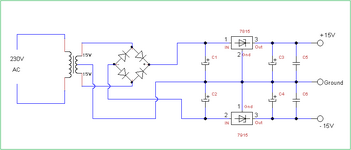VirusX2
Member level 4

Hi all,
i have an 60VA transformer with 2x15V secondary, rated at 2A each. I want to use it on a dual symmetrical dc power supply with outputs, +15V,-15V.
The circuit is with filtering capacitor and LM7815/LM7915 on each rail.
Except of the dual supply loads such as op-amps and transducers, i have some single-ended loads from +15V to common 0V and from -15V to common 0V.
Lets say i need 1.3A from +15V to common 0V, 50mA from -15V to common 0V, and 150mA symmetrical load on+15V/-15V
I am a little confused. Can you help me calculate the the total AC RMS current needed from the transformer?
I attached the circuit.
Thank you.
i have an 60VA transformer with 2x15V secondary, rated at 2A each. I want to use it on a dual symmetrical dc power supply with outputs, +15V,-15V.
The circuit is with filtering capacitor and LM7815/LM7915 on each rail.
Except of the dual supply loads such as op-amps and transducers, i have some single-ended loads from +15V to common 0V and from -15V to common 0V.
Lets say i need 1.3A from +15V to common 0V, 50mA from -15V to common 0V, and 150mA symmetrical load on+15V/-15V
I am a little confused. Can you help me calculate the the total AC RMS current needed from the transformer?
I attached the circuit.
Thank you.


